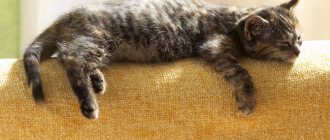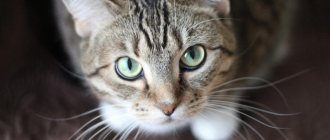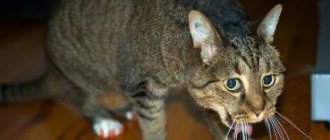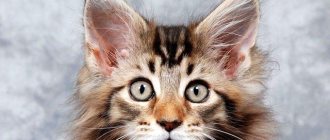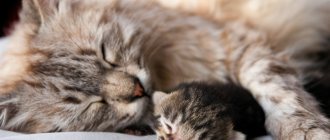10034Pavel
2
Like all animals, cats unfortunately get sick. They have a runny nose, sneezing, and cough. Therefore, animal owners need to know how to rinse their cat’s nose if he is sick. A cold or respiratory tract infection can occur at any time, especially during the autumn-winter and spring-summer transitional climate periods. The cat eats and drinks poorly, becomes lethargic, has difficulty breathing due to nasal congestion, he sneezes and tries to free his nose from snot. The pet will need your help.
Can cats have their nose cleaned?
Sometimes an animal suffers from nasal congestion and cannot do anything about it.
It is recommended for cats to clean their nose in the following cases:
- with a runny nose;
- to remove contaminants.
A runny nose in a cat can be caused by various diseases. It is accompanied by nasal congestion, sneezing, and sometimes other symptoms.
To alleviate the animal's condition, it is important to clear its nose of snot.
The accumulation of dirt in the nasal passages is observed in every animal. This condition is manifested by wheezing, labored and slow breathing.
Causes and symptoms
Sneezing and discharge in an animal can be caused by infectious and non-infectious causes. Depending on this, you need to build treatment.
Colds and hypothermia
Cats have a very high immunity, and colds - so frequent and even commonplace for humans - are rather an exception to the rule for an animal. Colds and runny noses are more common in homeless cats during periods of cold and rain. Colds occur for several reasons:
- The room is too damp, drafty.
- High humidity.
- Lack of vitamins, poor nutrition.
- Sudden temperature changes.
- The animal is hypothermic or wet (this can happen if the cat, for example, is not dried well after bathing).
Symptoms that will indicate a cold:
- Dry or, conversely, hot nose.
- Hair loss or dullness.
- Great lethargy.
- The cat sleeps for a long time or gets very scared of something that didn’t bother her before.
- Weakness (the animal stands well on its feet, but is apathetic), increased fatigue.
- Decreased appetite.
With a cold, breathing becomes difficult, the snot is clear and not viscous. The cat sneezes and coughs heavily, and the eyes may water. If discharge sticks to the muzzle or crusts appear, this means that the disease is becoming serious and may progress to the pathological stage.
An animal can breathe through its mouth to facilitate the process of obtaining oxygen, but if this happens constantly and the nose is not involved, you should immediately consult a doctor.
Allergy
If the animal sneezes, tries to constantly rub its eyes and nose, and discharge of a transparent texture appears from the eyes, most likely, we are talking about an allergic rhinitis. The snot in this case is liquid, transparent in color (odorless), and may be accompanied by swelling and dermatitis. Breathing is impaired and itching is likely.
REFERENCE
Cats can develop allergies to a certain product. After consultation with a veterinarian and tests, he will have to be ruled out. There may be allergies to medications, pollen, house plants, and even household items. Most often, the animal reacts to the irritant after several hours, but symptoms can appear several days after encountering the allergen.
Fungi and bacteria
Human ARVI, most often, is not transmitted to cats, but if the disease is caused by certain fungi and bacteria, then both the owner and the pet can become infected with a runny nose.
A bacterial infection is indicated by:
- unpleasant smell of discharge and its yellow-green color;
- accumulation of pus in the corners of the eyes or over the entire surface;
- snot from the nose and tears from the eyes;
- constant sneezing and coughing;
- the animal constantly swallows, this is due to the fact that mucus accumulates in the nasopharynx;
- body temperature rises;
- loss of appetite;
- dehydration;
- prolapse of the third eyelid.
Fungal infections overwhelm animals with weak immunity and often the runny nose becomes chronic. An indicator of a bacterial infection is a crust in the nose, which makes breathing very difficult and snot comes out of the nose.
Important! If the polyps have grown, the animal's face will become deformed. This is dangerous because the inflammation spreads to the brain; the symptoms of this are seizures.
Video about runny nose in cats:
Foreign bodies
Coughing and sneezing may be caused by a cat swallowing a foreign object in its intestines or esophagus. If this happens, the symptoms will be as follows:
- Profuse salivation.
- If a foreign body is in the throat, then coughing and wheezing appear, the tongue turns blue, and the cat may lose consciousness.
- Constant swallowing.
- Vomiting and belching.
- Complete lack of appetite.
- Bloating.
- Lethargy, apathy, drowsiness.
- Diarrhea, constipation.
- Symptoms of general intoxication.
Congenital pathologies
A runny nose can result from birth defects and injuries. For example, a “cleft palate,” that is, disturbances in the structure of the upper jaw and nasal bones, will cause the cat difficulty breathing and wheezing. Injuries to the jaw or head can result in a cleft palate. The bones can become displaced, and all this together will give the animal a chronic runny nose.
Important! If rhinitis does not go away for a long time or occurs periodically, be sure to contact your veterinarian.
With such pathologies, the discharge does not have an unpleasant odor and most often does not affect the general condition of the cat (if the injury is cured and is not life-threatening). To clarify the causes of chronic runny nose, you should contact your veterinarian. He will identify the pathology and tell you whether it is possible to treat it or eliminate the symptoms.
Inflammation (ears, teeth, gums)
A runny nose can be an indicator of inflammation that occurs in the nasopharynx or ears. And it will not go away until the initial inflammation is removed.
Why do cats get ear infections?
- Infections.
- Hypothermia.
- Other specific diseases.
Why gums and teeth can become inflamed:
- Malocclusion.
- Lack of vitamins.
- Caries.
- Tartar.
- Injury.
- Irradiation.
- Virus.
- Chemical poisoning.
With inflammation, the following clinical picture is observed:
- breathing quickens;
- discharge from the eyes becomes watery;
- the animal periodically breathes through its mouth;
- sneezing occurs infrequently;
- purulent snot, gray-green, whitish, yellow, sometimes even with traces of blood;
- loss of appetite.
Other causes of runny nose
Other problems that cause coughing, sneezing and sniffles include:
- Parasites, for example, worms.
- Tumor of the nasopharynx.
- Neoplasms.
- Chronic diseases.
- Infections.
- Stress.
Basic cleaning rules
It is necessary to clean your pet's nose when it is dirty and from snot.
It's important to do it right.
In order not to scare the animal and quickly carry out the procedure, you should adhere to the following rules:
- the first rinsing is performed under the supervision of a veterinarian;
- It is not allowed to use medications that are used to wash a person’s nasal passages;
- nasal cleaners must be purchased at a veterinary pharmacy;
- You cannot use folk remedies based on salt, iodine or soda, since these components can cause swelling of the nasal mucosa and allergic reactions;
- Each nostril should be rinsed.
Before the procedure, the pet should be immobilized and calmed. To do this, wrap it in a towel or other soft but durable material. After completing the actions, the animal needs to be encouraged - petted and given its favorite dish.
Instructions for use
Nasal rinsing, subcutaneous administration and other methods of using saline for a cat require prior approval from a veterinarian. In most cases, it is recommended to administer the product using a drip system. When placing an IV, adhere to the following rules:
- The saline solution should be warm and administered slowly.
- Prevent air from entering the cat's vein, which will cause life-threatening complications.
- When performing the manipulation, the pet is monitored by a veterinarian or owner in order to notice changes in its condition in time and take the necessary measures.
It is better to put an IV in a hospital setting. The manipulation is performed in several stages:
The system through which the drug will flow into the animal’s vein must be connected to the catheter.
- Correctly prime the infusion system.
- The cat is placed on its left or right side, and the surface should be soft, even and comfortable.
- The catheter is unbandaged and rinsed with saline solution.
- Unscrew the cap from the catheter, connecting the drip system.
- Open the clamp and set the injection rate. 20 drops per minute are recommended.
- The medicine is injected into the IV using a syringe with a needle.
- At the end of the manipulation, close the clamp and screw on the cap.
- Open the top valve, flush the catheter and roll it up.
It takes 2 hours to administer 100 ml of saline to a cat.
You can also rinse your cat’s nose with the drug or use it subcutaneously up to 2 times a day. For the procedure you will need a 0.6 mm syringe, and the solution is injected quickly. If the owner does everything correctly, then the pet feels good and no adverse reactions are observed. The pet recovers after a few days.
Nasal rinses
The cat can be washed with the following preparations:
- Dioxidine. It is recommended to dilute this medicine with Naphthyzin nasal drops for children in a 1:1 ratio.
- Saline solution. Most often offered in ampoules.
- Special solutions for washing. Gamavit is used to cleanse the upper respiratory tract. Mastiet forte is also considered an effective remedy.
- Furacilin. To prepare the product, you need to dissolve ¼ of the tablet in a glass of warm water.
- Chlorhexidine. It is recommended to dilute the drug with water in a 1:1 ratio.
These products should be purchased from a veterinary pharmacy.
Alternative rinses include:
- aloe juice;
- beet juice.
You can use decoctions of medicinal plants. It is best to use oak bark, chamomile, and string.
It is important to remember that the juices of these plants must be diluted with warm boiled water . These products should be used freshly squeezed and not concentrated.
Water and aloe or beet juice are diluted in a ratio of 1:4.
Cleaning your nose when you have a runny nose
Cleaning your cat's nasal passages will help relieve your pet of a runny nose. It is carried out according to the following algorithm src=»https://nashakisa.ru/wp-content/uploads/2019/01/foto-9-1-360×270.jpg» class=»aligncenter» width=»360″ height= "270"[/img]
- The rinsing solution is carefully drawn into the syringe. The dosage should not exceed 0.5 ml. The needle is removed from the syringe. You can also use a pipette.
- The animal is wrapped in thick cloth or a towel to avoid scratches. To calm your pet, it is also recommended to attach a clothespin to the withers.
- The end of the syringe is carefully inserted into the nasal passage.
- The liquid is introduced slowly. Gently press the syringe plunger.
- You need to rinse each nostril with the solution.
- After this, wipe off the discharge with a cotton pad. It can be replaced with a small cotton wool turunda.
For a runny nose, use saline or other means. An effective procedure is rinsing with Chlorhexidine or Furacilin.
Usually a cat’s rhinitis goes away after 1-2 manipulations.
If other symptoms of the disease develop or the washing procedure is ineffective, it is necessary to show the cat to a veterinarian.
Cleaning from dirt
Veterinarians say that the animal's nasal passages clear themselves, so intervention is usually not required. But if your cat is acting restless or exhibiting other symptoms, she should have her nose cleaned.
The washing steps should be as follows:
- Draw boiled water at room temperature into a syringe or pipette.
- Immobilize the pet using a clothespin at the withers or wrapping it in thick material.
- With one hand, support the animal by the head, and with the other, pour in the solution in a thin stream. Liquids are drawn into the syringe no more than 0.5 ml.
- After rinsing one nostril, the manipulation is repeated with the other.
- Remove dirt with a cotton swab.
It is important to calm the animal . To do this, it is recommended to stroke it. Upon completion of the procedure, the pet must be rewarded by giving it a favorite treat.
How to take care of your kitten's health
You should also not forget that the animal’s fur must be regularly checked for the presence of parasites, and if they are detected, the fur must be treated with special means - drops or sprays. Also, anthelmintic prophylaxis must be carried out at least 2 times a year. The veterinary clinic will tell you what vaccinations and when they need to be done. You can read more about the health of a kitten and how to take care of it here.
Video that talks about how to care for a kitten:
Today we talked about how to care for cats and kittens, and how to do it correctly.
If you are not afraid of all these difficulties and difficulties associated with caring for a kitten, feel free to have an animal in your home. You will be pleasantly surprised, but very soon you will notice that in fact, there is nothing difficult or complicated in such care, but only pleasant moments that bring you even closer to your cat.
How do you take care of your kitten? What difficulties did you face when this pet arrived in your home? Share your experience with us - we are waiting for your comments and photos of your pets on the pages of our VKontakte group.
If you have difficulty choosing a name for a kitten, then the article “How to choose a name for a kitten” will definitely help you name your pet, and here - “Accessories for a cat” you will learn about what accessories you will need to purchase for your little one. pet.
We are waiting for your feedback and comments, join our VKontakte group!
Cats are susceptible to a variety of diseases throughout their lives. Furry pets may develop rhinitis, coughing, sneezing, nasal congestion that interferes with normal breathing, or a respiratory infection, so the animal may need the owner's help. Let's look at how to properly rinse a cat's nose at home, what medications and products to use.
Features of the procedure in newborn kittens
A newborn kitten will also occasionally need to clean out postpartum discharge from her nose. Sometimes the procedure needs to be done in order to free the baby’s nostrils from contamination.
The kitten also has a runny nose, which prevents it from breathing. Therefore, the nasal passages should be cleared of snot.
Since kittens' nasal passages are very small, they should be cleaned carefully.
The procedure is characterized by its own characteristics:
- washing must be done with a pipette;
- do not use a syringe;
- the kitten is immobilized with a towel;
- approximately 0.2-0.3 ml of solution is injected;
- the liquid should not be too cold or hot;
- the solution is poured into each nasal passage.
You can clean your kitten's nose with saline solution, Chlorhexidine or boiled water.
The most dangerous diseases
A runny nose is a symptom of the most dangerous viral diseases:
- Calcivirosis.
- Rhinotracheitis.
- Panleukopenia.
Calcivirosis
An extremely contagious viral infection. Characterized by fever, rhinitis and stomatitis. Kittens taken from their mothers become ill.
Those who recover gain lifelong immunity, but become spreaders of the virus. If the disease is not treated, 30% of clinically ill patients die.
Ulcerative stomatitis is considered a striking additional symptom. This makes it difficult for the kitten to swallow. He refuses to eat and loses weight. Gingivitis occurs, characterized by inflammation of the gums. A runny nose is accompanied by a cough, and bronchopneumonia develops. If pulmonary edema occurs, the kitten dies.
Rhinotracheitis
Rhinotracheitis is caused by the herpes virus. Develops rhinitis, conjunctivitis and tracheitis. The kitten cries and sneezes, having recovered from the disease, it becomes a carrier of the virus, gaining lifelong immunity. Hypothermic cubs and unvaccinated individuals become ill. Unbalanced nutrition and overcrowding increases the risk of epizootics.
The signs of the disease are similar to the symptoms of Calcivirosis, but the ulcers do not appear on the mucous membrane of the mouth, but on the cornea of the eye. In kittens, necrosis of nasal tissue and bone resorption are observed.
Rhinotracheitis
Panleukopenia
Panleukopenia is a dangerous disease with high mortality. Survivors within 100 hours become reservoirs of Parvovirus. Contagium is transmitted by blood-sucking exoparasites.
There is no placental barrier; kittens receive the virus in utero. Intermittent fever is characteristic. First, body temperature rises 2 °C above normal, and after 2 days it drops 1 °C below the limit.
The pulmonary variant of panleukopenia is characterized by purulent discharge from wear and tear and eyes. Cloudy films and hemorrhages appear on the mucous membranes. The mortality rate is, on average, 50%.
Panleukopenia
